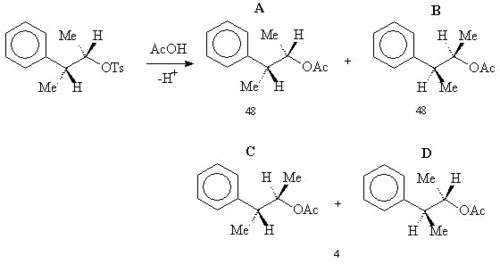Neighbouring group participation
Neighbouring group participation (NGP) (also known as anchimeric assistance) in organic chemistry has been defined by IUPAC as the interaction of a reaction centre with a lone pair of electrons in an atom or the electrons present in a sigma bond or pi bond . When NGP is in operation it is normal for the reaction rate to be increased. It is also possible for the stereochemistry of the reaction to be abnormal (or unexpected) when compared with a normal reaction. While it is possible for neighbouring groups to influence many reactions in organic chemistry (e.g. the reaction of a diene such as 1,3-cyclohexadiene with maleic anhydride normally gives the endo isomer because of a secondary effect {overlap of the carbonyl group π orbitals with the transition state in the Diels-Alder reaction}) this page is limited to neighbouring group effects seen with carbocations and SN2 reactions.
NGP by heteroatom lone pairs
A classic example of NGP is the reaction of a sulfur or nitrogen mustard with a nucleophile, the rate of reaction is much higher for the sulfur mustard and a nucleophile than it would be for a primary alkyl chloride without a heteroatom.

In sugar chemistry anchimeric assistance is an example of NGP.
NGP by an alkene
The π orbitals of an alkene can stabilize a transition state by helping to delocalize the positive charge of the carbocation. For instance the unsaturated tosylate will react more quickly (1011 times faster for aqueous solvolysis) with a nucleophile than the saturated tosylate.

The carbocationic intermediate will be stabilized by resonance where the positive charge is spread over several atoms, in the diagram below this is shown.

Here is a different view of the same intermediates.

Even if the alkene is more remote from the reacting center the alkene can still act in this way. For instance in the following alkyl benzenesulfonate the alkene is able to delocalise the carbocation.

Also the increase in the rate of the SN2 reaction of allyl bromide with a nucleophile compared with the reaction of n-propyl bromide is because the orbitals of the π bond overlap with those of the transition state. In the allyl system the alkene orbitals overlap with the orbitals of a SN2 transition state.

NGP by a cyclopropane, cyclobutane or a homoallyl group
If Cyclopropylmethyl chloride is reacted with ethanol and water then a mixture of 48% cyclopropylmethyl alcohol, 47% cyclobutanol and 5% homoallyl alcohol (but-3-enol) is obtained. This is because the carbocationic intermidate is delocalised onto many different carbons through a reversible ring opening.
NGP by an aromatic ring
In the case of a benzyl halide the reactivity is higher because the SN2 transition state enjoys a similar overlap effect to that in the allyl system.

An aromatic ring can assist in the formation of a carbocationic intermediate called a phenonium ion by delocalising the positive charge.

When the following tosylate reacts with acetic acid in solvolysis then rather than a simple SN2 reaction forming B, a 48:48:4 mixture of A, B and (C+D) was obtained .

The mechanism which forms A and B is shown below.

External links
- A PhD thesis written on this subject is at .
- IUPAC definition
References
- ^ Advanced organic chemistry, page 314, Jerry March (4th Ed), Wiley-Interscience.
- ^ Studies in Stereochemistry. I. The Stereospecific Wagner-Meerwein Rearrangement of the Isomers of 3-Phenyl-2-butanol Donald J. Cram J. Am. Chem. Soc.; 1949; 71(12); 3863-3870. Abstract
- ^ Studies in Stereochemistry. V. Phenonium Sulfonate Ion-pairs as Intermediates in the Intramolecular Rearrangements and Solvolysis Reactions that Occur in the 3-Phenyl-2-butanol System Donald J. Cram J. Am. Chem. Soc.; 1952; 74(9); 2129-2137 Abstract.